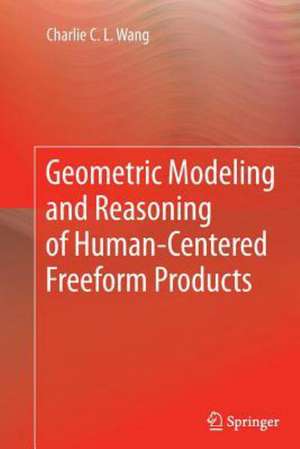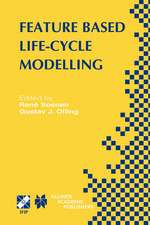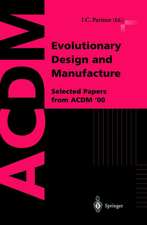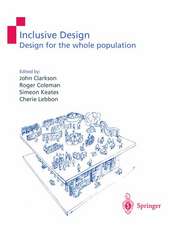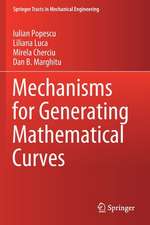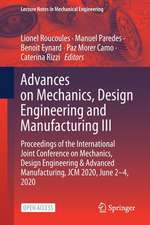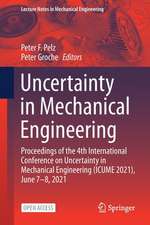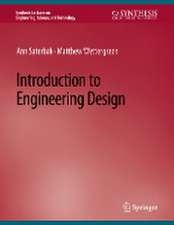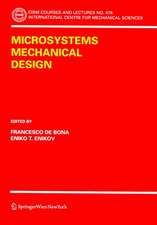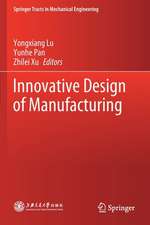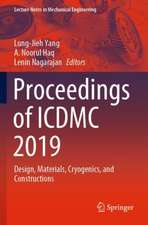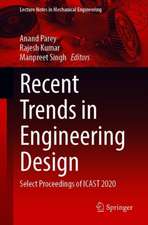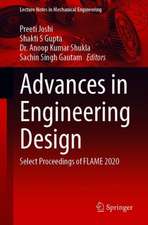Geometric Modeling and Reasoning of Human-Centered Freeform Products
Autor Charlie C. L. Wangen Limba Engleză Paperback – 20 sep 2014
Geometric Modeling and Reasoning of Human-Centered Freeform Products introduces the algorithms of human body reconstruction, freeform product modeling, constraining and reconstructing freeform products, and shape optimization for improving the manufacturability of freeform products. Based on these techniques, the design automation problem for human-centered freeform products can be fundamentally solved.
Researchers and developers working on problems of automatic designing individually customized products can use this book as a reference, and it can also be used in courses in computer-aided product design at the graduate level.
| Toate formatele și edițiile | Preț | Express |
|---|---|---|
| Paperback (1) | 637.59 lei 6-8 săpt. | |
| SPRINGER LONDON – 20 sep 2014 | 637.59 lei 6-8 săpt. | |
| Hardback (1) | 643.84 lei 6-8 săpt. | |
| SPRINGER LONDON – 12 aug 2012 | 643.84 lei 6-8 săpt. |
Preț: 637.59 lei
Preț vechi: 750.11 lei
-15% Nou
Puncte Express: 956
Preț estimativ în valută:
122.02€ • 132.49$ • 102.49£
122.02€ • 132.49$ • 102.49£
Carte tipărită la comandă
Livrare economică 22 aprilie-06 mai
Preluare comenzi: 021 569.72.76
Specificații
ISBN-13: 9781447159001
ISBN-10: 1447159004
Pagini: 240
Ilustrații: XII, 228 p.
Dimensiuni: 155 x 235 x 13 mm
Greutate: 0.34 kg
Ediția:2013
Editura: SPRINGER LONDON
Colecția Springer
Locul publicării:London, United Kingdom
ISBN-10: 1447159004
Pagini: 240
Ilustrații: XII, 228 p.
Dimensiuni: 155 x 235 x 13 mm
Greutate: 0.34 kg
Ediția:2013
Editura: SPRINGER LONDON
Colecția Springer
Locul publicării:London, United Kingdom
Public țintă
ResearchCuprins
Digital Human Body.- Geometry of Freeform Products.- Design Automation of Human-Centered Products.- Manufacturability of Products Fabricated by Planar Materials.- Case Studies of Apparel Products.- Application to Other Human-Centered Products.
Notă biografică
Dr. Charlie C. L. Wang is currently an Associate Professor at the Department of Mechanical and Automation Engineering, The Chinese University of Hong Kong, where he began his academic career in 2003. He gained his B.Eng. (1998) in Mechatronics Engineering from Huazhong University of Science and Technology, M.Phil. (2000) and Ph.D. (2002) in Mechanical Engineering from the Hong Kong University of Science and Technology. He is a member of ASME and IEEE, and Chairman of Technical Committee on Computer-Aided Product and Process Development (CAPPD) of ASME. He is currently on the editorial board of Computer-Aided Design journal and International Journal of Precision Engineering and Manufacturing, and is an Associate Editor of Journal of the Chinese Institute of Industrial Engineers and International Journal of Virtual Reality. Dr. Wang has received a few awards including the ASME CIE Young Engineer Award (2009), the CUHK Young Researcher Award (2009), the CUHK Vice-Chancellor's Exemplary Teaching Award (2008), the Best Paper Awards of ASME CIE Conferences (in 2008 and 2001), and the Prakash Krishnaswami CAPPD Best Paper Award of ASME CIE Conference in 2011. His current research interests include geometric modeling in computer-aided design and manufacturing, biomedical engineering and computer graphics, as well as computational physics in virtual reality.
Textul de pe ultima copertă
The recent trend in user-customized product design requires the shape of products to be automatically adjusted according to the human body’s shape, so that people will feel more comfortable when wearing these products. Geometric approaches can be used to design the freeform shape of products worn by people, which can greatly improve the efficiency of design processes in various industries involving customized products (e.g., garment design, toy design, jewel design, shoe design, and design of medical devices, etc.). These products are usually composed of very complex geometric shapes (represented by free-form surfaces), and are not driven by a parameter table but a digital human model with free-form shapes or part of human bodies (e.g., wrist, foot, and head models).
Geometric Modeling and Reasoning of Human-Centered Freeform Products introduces the algorithms of human body reconstruction, freeform product modeling, constraining and reconstructing freeform products, and shape optimization for improving the manufacturability of freeform products. Based on these techniques, the design automation problem for human-centered freeform products can be fundamentally solved.
Researchers and developers working on problems of automatic designing individually customized products can use this book as a reference, and it can also be used in courses in computer-aided product design at the graduate level.
Geometric Modeling and Reasoning of Human-Centered Freeform Products introduces the algorithms of human body reconstruction, freeform product modeling, constraining and reconstructing freeform products, and shape optimization for improving the manufacturability of freeform products. Based on these techniques, the design automation problem for human-centered freeform products can be fundamentally solved.
Researchers and developers working on problems of automatic designing individually customized products can use this book as a reference, and it can also be used in courses in computer-aided product design at the graduate level.
Caracteristici
Discusses how to use geometric approaches to design the freeform shape of products that are worn by human bodies Introduces the newly developed geometric solution for the design automation of customized freeform objects, which can greatly improve the efficiency of design processes in various industries involving customized products Covers the algorithms of human body reconstruction, freeform product modeling, constraining and reconstructing freeform products, and shape optimization for improving manufacturability Includes supplementary material: sn.pub/extras
